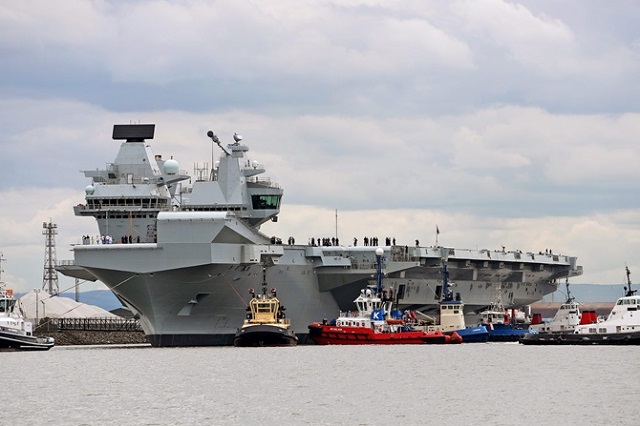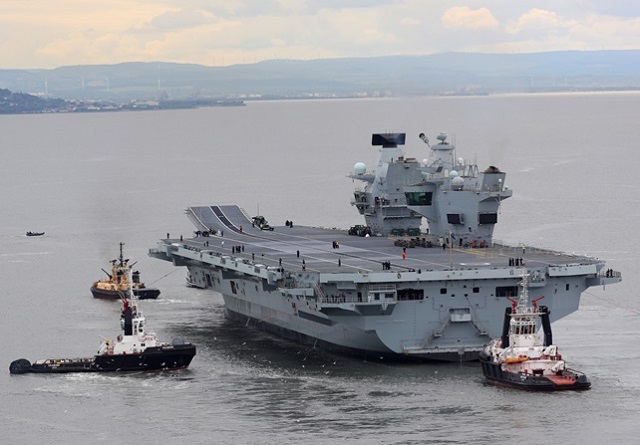HMS Queen Elizabeth Sets Sail
The Royal Navy’s largest ever warship put to sea on Monday for the first time to commence sea trials off the coast of Scotland.
In a delicate operation lasting nearly four hours, HMS Queen Elizabeth moved from the basin at Rosyth, where she has been under construction since 2014, and into the Forth estuary.
There was just 14 inches (35cm) either side of the hull as the carrier squeezed through the lock at Rosyth, and 20 inches (50cm) separated the keel from the lock bottom as 11 tugs assisted Queen Elizabeth into the Forth. The maneuver was practiced more than 30 times in simulators.
 More than 700 sailors, led by Commanding Officer Captain Jerry Kyd, and 200 industry contractors have sailed on her maiden voyage.
More than 700 sailors, led by Commanding Officer Captain Jerry Kyd, and 200 industry contractors have sailed on her maiden voyage.
The ship will spend an initial period of around six weeks at sea to test the fundamentals of the ship. She will then return to Rosyth for further testing and maintenance before heading back to sea for a second stage which aims to test her mission systems. She will transit to her home port of Portsmouth Naval Base to be handed over to the Royal Navy later this year.

Once in service, Queen Elizabeth will be the largest aircraft carrier in the world outside the U.S. She is the largest and most powerful warship ever constructed for the Royal Navy. The ship will operate with a crew of approximately 700, increasing to the full complement of 1,600 when aircraft are in operation.

that matters most
Get the latest maritime news delivered to your inbox daily.
Defence Secretary Sir Michael Fallon said: “This is a historic moment for the U.K., as our new aircraft carrier takes to sea for the very first time. This floating fortress is by far the most powerful ship ever built in Britain that will enable us to tackle multiple and changing threats across the globe.
“For the next 50 years she will deploy around the world, demonstrating British power and our commitment to confronting the emerging challenges from a dangerous world.”
HMS Queen Elizabeth’s sister ship, HMS Prince of Wales is structurally complete and is currently in the outfitting phase of her program. Each aircraft carrier, coupled with the F-35B Lightning aircraft, will form an integral part of the U.K.’s Carrier Strike capability.
The aircraft carriers are being delivered by the Aircraft Carrier Alliance, a unique partnering relationship between BAE Systems, Thales U.K., Babcock and the Ministry of Defence.
Key Facts
* Each carrier weighs 65,000 tons.
* Each carrier is 280 meters (920 feet) in length.
* Top speed is upwards of 25 knots.
* The flight deck is 70 meters (230 feet) wide and 280 meters long – enough space for three football pitches.
* Each carrier is made up of 17 million parts.
* There are 364,000 meters (226 miles) of pipes inside each of the ships.
* 51 million hours have been spent designing and building the Queen Elizabeth class.
* The entire ship’s company can be served a meal within 90 minutes, 45 minutes when at action station.
* Each carrier keeps 45 days’ worth of food in its stores.
* The location and design of the storage facilities means 20 people can replenish the ship’s stores in half a day.
* The aircraft carriers are the first Royal Navy vessels to have piped oxygen within the medical complex.
* At the push of a button pallets of munitions can be moved from the magazines deep in the weapons preparation area to the flight deck where they can be loaded onto aircraft.
* 220 cameras allow monitoring of engine and machinery spaces, external catwalk, aircraft hangars, ship entrances and access to classified areas.
